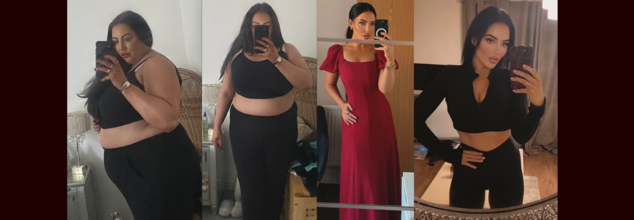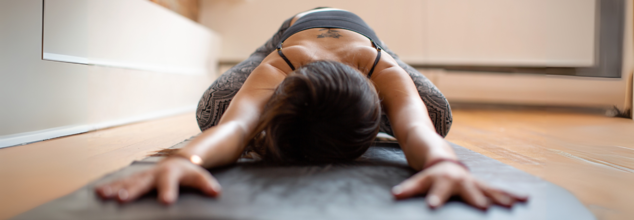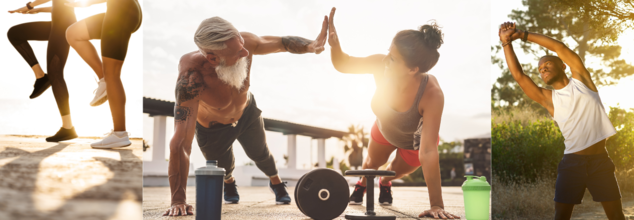- Health Conditions A-Z
- Health & Wellness
- Nutrition
- Fitness
- Health News
- Ayurveda
- Videos
- Medicine A-Z
- Parenting
- Web Stories
Forget Ozempic! Woman With A Rare Condition Reveals How This One Daily Exercise Helped Her Lose 140 Pounds In 2 Years

Credits: Hannah Mai/Daily Mail (SWNS)
Dominated by buzzworthy injections like Ozempic and Mounjaro, one woman’s extraordinary story is flipping the narrative. Meet Hannah Mai, a 37-year-old from Coventry, UK, who defied medical odds, overcame a rare hormonal condition, and shed 140 pounds naturally—all without relying on weight-loss drugs.
Diagnosed with Cushing’s disease, a condition marked by dangerously high cortisol levels, Hannah’s weight loss journey wasn’t just about slimming down, it was her battle to reclaim her body con, her identity, and her well-being. Her secret? Daily Pilates, relentless determination, and a clean, protein-rich diet.
For Hannah, sudden and uncontrollable weight gain started around age 30. Despite maintaining a healthy lifestyle and weighing about nine stone (126 pounds) for most of her adult life, she began gaining weight rapidly—seven stone (nearly 100 pounds) in just a few months.
“It was terrifying,” Hannah recalls. “I hadn’t changed my diet. People asked if I was pregnant. I knew something was wrong, but no one believed me.”
Doctors initially dismissed her concerns, chalking up her symptoms to hormones or lifestyle. But the weight kept piling on, eventually reaching 20st 5lbs (285 pounds). More than two years later, her body delivered an unmistakable warning sign—a sudden hunch in her back.
This prompted her to do her own research, where she found a possible explanation: Cushing’s disease, a rare condition caused by excess cortisol. Armed with her findings, she returned to her doctor, this time with a printed list of symptoms in hand.
Cushing’s disease, which affects fewer than 10 people per million each year, is often caused by a non-cancerous tumour on the pituitary gland. This tumour leads to the excessive production of adrenocorticotrophic hormone (ACTH), which in turn signals the adrenal glands to release too much cortisol.
Cortisol, the body’s main stress hormone, affects nearly every system, regulating blood sugar, metabolism, and inflammation but too much of it wreaks havoc, resulting in weight gain (particularly around the trunk and face), thinning skin, mood changes, and high blood pressure.
Hannah’s case was textbook. In October 2020, she was finally diagnosed through MRI scans and blood tests at University Hospital Coventry & Warwickshire. A few months later, in February 2021, she underwent brain surgery to remove the tumour, followed by two years of steroid therapy to help her body rebalance.
By 2023, Hannah’s health had stabilized enough for her to discontinue the steroids. That’s when she decided it was time to take back control of her body.
But rather than jumping on the Ozempic bandwagon, she took a different route a holistic, lifestyle-based approach that focused on daily Pilates, clean eating, and discipline.
“I think Ozempic is great for people who need it medically,” she said. “But I wanted to prove to myself that I could do this. And once I started seeing results, I just kept going.”
Why Pilates Is Beneficial For Gaining Gentle Strength?
For Hannah, the cornerstone of her recovery wasn’t running marathons or punishing herself with extreme workouts. It was Pilates—a low-impact, mind-body exercise that emphasizes strength, flexibility, and alignment.
Done daily, Pilates became her physical therapy, mental reset, and weight-loss weapon.
“Pilates helped me reconnect with my body in a way I hadn’t felt in years. It didn’t stress my joints or overwhelm me,” she explained. “It was something I could do every day—and it worked.”
Combined with a high-protein, low-carb diet tailored for her body’s needs (and free from sugar, dairy, and gluten due to a celiac diagnosis), the results were astonishing: a drop from size 26 to size 10, and a weight loss of 140 pounds over two years.
Hannah’s journey isn’t just about the number on the scale. It’s about resilience, self-advocacy, and trusting your intuition especially when the medical system doesn’t listen.
“When I look at old photos, I feel sad about how far things got. But it also reminds me of how far I’ve come,” she reflected. “I’m proud of myself. And I want others to know it’s possible.”
In a world obsessed with fast fixes and injectables, Hannah’s story is a powerful reminder that transformations come in many forms. Her message is one of patience, persistence, and purpose the kind of inspiration that can’t be bottled in a prescription pen.
Why Is Cushing’s Disease Often Misdiagnosed?
Cushing’s disease is often underdiagnosed, especially in women, whose weight gain is often dismissed as lifestyle-related or hormonal fluctuation. As awareness grows, thanks to celebrities like Amy Schumer, who recently revealed her own Cushing’s diagnosis more people are starting to recognize the symptoms and seek help.
“I knew for years something was wrong with me,” Hannah said. “But I had to fight to be heard.”
Her journey underscores the importance of self-education, advocacy, and second opinions, especially when it comes to mysterious or unexplained symptoms.
As the popularity of weight-loss injections like Ozempic and Mounjaro skyrockets, Hannah’s story offers a refreshing counterpoint. Yes, medications have their place but not every weight-loss story begins or ends with a shot.
Yoga & Weight Loss - How To Burn Calories With Yoga?

(Credit-Canva)
Many people think of yoga as just gentle stretching and meditation, not a serious workout for burning calories. But the truth might surprise you! While yoga certainly brings mental calm, it's also a powerful way to engage your body.
Yoga is a fantastic blend of strength, flexibility, balance, and endurance. Experts estimate that an hour of yoga can burn anywhere from 180 to 600 calories. This wide range depends on the style; intense types like Bikram or power yoga will burn more than a gentle, restorative class. To maximize calorie, burn, choosing specific poses is key.
Yoga For Weight Loss
Harvard Health suggests that yoga can help you manage stress, lift your mood, reduce emotional eating, and build a supportive community. All these benefits can be incredibly helpful for both losing weight and keeping it off.
Beyond these mind-body benefits, yoga can also help you burn calories and build stronger, more toned muscles. It might even reduce joint pain, making it easier for you to be more active every day. These are just a few of the many ways yoga can support your health journey.
Plank
This pose is a calorie-burning powerhouse because it forces all your muscles to work against gravity. To burn even more, try lifting one foot slightly off the mat. The longer you hold it – from 30 seconds to five minutes – the more calories you'll melt away.
Chair Pose
Chair pose gets your body's largest muscles, the glutes, working hard, which automatically burns lots of calories. It's a safe and effective move for everyone, regardless of their yoga experience.
Chaturanga (Low Push-Up)
Chaturanga is like holding the bottom of a push-up. When done correctly, it engages most of your major muscle groups. Your core, legs, and arms all work to maintain a perfect 90-degree bend in your elbows. It's a challenging pose that requires focus and control, even for advanced yogis.
Wheel Pose
Wheel pose is an advanced backbend that opens your chest and stretches the entire front of your body. It deeply engages your legs, glutes, shoulders, arms, and even your heart and lungs. You can boost your heart rate even more by doing this pose in a heated room after a good warm-up.
High Lunge
You've probably seen High Lunge in other workouts because it's a full-body move, especially effective for your glutes and quads. This pose also builds strength and requires balance. Any time you add balance to a pose, your body has to work harder, leading to more calories burned.
Sun Salutations
Sun Salutations are a sequence of 12 flowing poses that get your heart pumping. They engage your abs, glutes, calves, shoulders, biceps, and triceps. This series combines breath with movement, energizing, strengthening, and stretching your muscles, while also boosting blood oxygen and strengthening your lungs.
Dolphin Pose
Dolphin pose is similar to downward dog but with your forearms on the mat. It's fantastic because it both strengthens your arms, core, and legs, while also stretching your shoulders and chest. Having your forearms down fully engages your triceps too, making it a powerful pose for overall body engagement.
Heart Surgeon Says THESE Are The Best Exercises For Your Long-Term Heart Health

(Credit-Canva)
Our heart health is the core of our well-being, lack of exercise, proper food intake and other bad lifestyle habits often put a lot of strain on our hearts. While doctors do emphasize that exercising above all else, many people wonder which exercise is the best to improve their heart health.
To answer this, top US surgeon Dr. Jeremy London, a board-certified cardiovascular surgeon posted a video on Instagram, underlining what exercise he thinks will help our heart the best. He says that aerobic exercise is the best kind of workout for your heart. This type of exercise makes your heart and blood system work better, which helps prevent heart problems. We can measure how well your heart works using something called VO2 max.
What is Aerobic Exercise?
Aerobic exercise is any physical activity that gets your big muscles moving in a steady, repeated way. You can choose how hard your body works during these exercises. Doctors use these exercises to also measure how well you are doing with a VO2 max
The word "aerobic" means "with oxygen." When you do aerobic exercise, your breathing helps get oxygen to your muscles. This oxygen helps your body burn energy and keep moving. There are many different types of aerobic exercises. Some common ones include:
Walking or jogging
Walking is one of the easiest aerobic exercises to start with. You can walk at a pace that feels right for you. Jogging is faster than walking but slower than running. It puts more stress on your joints, so it's not a good idea if you have an injury. All you really need are good shoes. You can walk almost anywhere – outside, in a mall, or on a treadmill – which makes it easy to do all year round. Walking is a great way to begin an exercise routine.
Cycling
You can cycle on a stationary bike or a regular bicycle. You can make it harder by choosing a higher setting on a stationary bike or by riding on hills. Cycling is a good choice if you have joint problems like arthritis, because it's easy on your back, hips, knees, and ankles. If you cycle outdoors, though, bad weather might stop you.
Using cardio machines
Cardio equipment refers to machines that get your heart rate up with repeated movements. Some popular ones are rowing machines, stair climbers, ellipticals, and treadmills. You'll find these at gyms, or you can buy one for your home. Since there are many kinds, it's a good idea to try them out at a gym first. This way, you can see which machine you like best and which one feels good on your body if you have any old injuries or issues. Your doctor can also suggest the best cardio machine for you.
Swimming
Swimming is a gentle activity where you use your arms and legs to move through water. Swimming in open water (like a lake) is usually more intense than in a pool. If you have joint pain, water aerobics or water walking are good alternatives because the water helps support your body, taking stress off your joints. If you're swimming or doing water activities, always make sure there's a lifeguard nearby in case of an emergency.
What is VO2 Max?
Think of VO2 max as a score that tells you how fit you are. Harvard Health explains that a higher score means you're in better shape. It also means you're less likely to get heart disease and may live longer.
When you breathe, your lungs take in oxygen. Your blood then carries this oxygen to your muscles. Your muscles need oxygen to create energy for you to move. The more oxygen you can use, the more energy your muscles have, and the better your workouts will be.
Focus on Your Weakest Link
Dr. London believes that the most important change you can make for your health is to figure out what you're not good at and work on that. He shared that even though he tries hard with his diet and exercise, his biggest challenge is sleep. “We all can do better in various places, but where can I really make meaningful shifts? Well, it's where I'm the weakest, not where necessarily I'm the strongest. And that is where the opportunity exists.”
How To Safely Exercise Outdoors This Summer?

Credits: Canva
With longer days and sunnier skies, summer is the perfect time to take your workout outdoors. Activities like walking, running, hiking, and cycling not only boost physical fitness but also offer mental health benefits thanks to fresh air and natural surroundings. But as temperatures rise, so do the risks of injuries and heat-related issues. Whether you're just starting a routine or stepping up your fitness game, taking a few precautions can make your summer workouts safer and more effective.
Aim for Consistency Over Intensity
Health guidelines from the World Health Organization (WHO) and the Center for Disease Control and Prevention (CDC) recommend at least 150 minutes of moderate-intensity aerobic activity per week, such as brisk walking, or 75 minutes of vigorous activity like running. Breaking this into manageable sessions — say, 30 minutes five times a week — can help improve cardiovascular health, support weight management, and enhance overall well-being.
However, jumping into intense workouts after a period of inactivity can backfire. Sudden changes in exercise habits often lead to soreness, injury, and burnout. Sports medicine experts advise starting slow and steady. Begin with a 15-minute daily walk and increase duration or intensity by no more than 10% per week. This gradual build-up helps your muscles, tendons, and joints adapt to new demands.
Don’t Skip Foot and Ankle Prep
Many outdoor exercisers underestimate how much stress is placed on the feet and ankles — especially on uneven terrain. Overuse injuries like plantar fasciitis, Achilles tendonitis, and shin splints are common during summer, when people return to outdoor running or hiking after a break.
Simple stretches can reduce the risk of these injuries. A towel stretch, where you sit with your legs extended and pull your toes toward you using a towel or resistance band, can improve flexibility in your calves, heels, and arches. Repeat this two to three times a day, especially before and after workouts.
Choose the Right Footwear
There’s no universal “best” shoe for walking or running. The right pair depends on your foot shape, arch type, gait, and the terrain you’re on. Comfort is key. Shoes should offer good arch support, shock absorption, and a snug — not tight — fit. If you’re not sure what suits you, visit a store that specializes in running or hiking gear for a gait analysis or professional fitting.
Visibility Can Be a Lifesaver
If you’re sharing roads or trails with vehicles or cyclists, being visible is non-negotiable. Wear bright, reflective clothing — especially in low light. Neon colors like yellow, green, and orange stand out during the day, while reflective vests, shoe strips, or LED bands can increase visibility at night. Always walk or run against traffic so you can see what’s coming.
Be Mindful of Your Surroundings
Outdoor exercise brings you closer to nature — but that also means unpredictable surfaces, tree roots, loose gravel, or broken sidewalks. Experts recommend scanning 15–20 feet ahead while walking or running to spot potential hazards. If you notice something tricky approaching, slow down, focus on your footing, and proceed with caution to avoid sprains or falls.
Don’t Go Off the Grid Alone
If you prefer solo hikes or runs, always tell someone your route and estimated return time. In case of injury or getting lost, this information could be critical. Carry a fully charged phone, and consider using GPS tracking apps or wearable fitness devices that share your location in real-time. If you do get injured and need to move, try hopping or using a stick as a crutch to reach help.
Listen to Your Body
Post-exercise soreness is normal, especially when trying a new route or increasing your activity. But pain that lingers for more than a few days, or feels sharp and localized, may need medical attention. A good rule of thumb: If your pain is above a 3 out of 10, or you notice swelling, limping, or limited range of motion, consult a healthcare provider. Applying ice, taking rest days, and using over-the-counter pain relievers may help with minor aches.
Science-Backed Benefits of Outdoor Exercise
Studies have shown that green exercise — physical activity performed in natural environments — enhances mood and reduces anxiety more than indoor workouts. Research published in Environmental Science & Technology found that just five minutes of activity in nature improves self-esteem and mood. Being outdoors also increases vitamin D exposure, which supports bone health and immunity.
© 2024 Bennett, Coleman & Company Limited

